Ricerca
The Meaning of Plants in Portraiture and Visual Culture from German-speaking Countries, circa 1470 to 1570
Lea Viehweger

Girl Making a Garland (verso of Portrait of a Young Man), Hans Süß von Kulmbach, ca.1508, oil on poplar, 17,8 x 14 cm, The Metropolitan Museum of Art, New York, Gift of J. Pierpont Morgan, 1917, Accession Number 17.190.21.
In the mid-sixteenth century, Philip Melanchthon excitedly writes to his friend Joachim Camerarius about a picture of a woman holding a flower he had seen in a Frankfurt pub. The image, we learn from Melanchthon, showed her making a wreath and was accompanied by an inscription in the vernacular which utilised the flower’s common German name Jelängerjelieber. Intrigued, Melanchthon puzzles about the meaning of the picture in relationship to the flower it features… Although the painting has long been lost, Melanchthon’s writings about the artwork and its plant convey the importance of the painted flower. His exchange demonstrates that plants were meant to be read – both in terms of their medical use and properties, as well as through their names.
This research project analyses the meaning of plants both in portraits and within the wider visual culture of German-speaking countries from circa 1470 to 1570 by examining the utilisation of contemporary proverb-like plant names such as Vergissmeinicht (‘forget-me-not’), Jelängerjelieber (‘the-longer-the-better’), or Maßliebchen (‘love-of-restraint’). From poetry to marriage treatise, sermons to medical recipes, and in inscriptions on artworks, these common plant names were employed to communicate ideals of love and gendered behaviour, to explain the nature of piety and devotion, and to mnemonically convey a plant’s medical use.
In a transdisciplinary approach, the project seeks to unite through an art historical focus the history of botany, social history, and literature studies in order to re-connect the surviving portraits with their 15th- and 16th-century context. By drawing on visual culture and material objects that include depictions of the plants found in portraits, this study aims to situate these portraits within the broader visual world to which they belonged, and consider the manner in which they would have been seen and interpreted by the contemporary viewer, creator, sitter and owner.
This approach hopes to reveal the (sometimes unexpectedly) close connections between material culture and painting, between vernacular proverbs and humanist studies, and between the intellectual occupation with plants and their vernacular use.
This project is part of the Research and Fellowship Program 4A Laboratory: Art Histories, Archaeologies, Anthropologies, Aesthetics, a cooperation between the Kunsthistorisches Institut in Florenz – Max-Planck-Institut and the Stiftung Preußischer Kulturbesitz.


